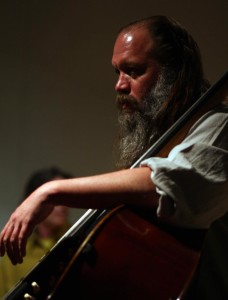A professional musician since the age of twelve, Mark is a visionary artist with a background in nonlinear mathematics, sacred systems, and cosmology. As a classically trained bassist and sitar player, he gained extensive experience in orchestral and world music ensembles, jazz combos, and solo sitar performance. While studying North Indian classical music with the legendary sitar and surbahar master Ustad Imrat Khan (younger brother of Ustad Vilayat Khan), Mark began delving deeper into the universal fundamentals of music and its underlying frequency structures. This in turn led him to his quest to develop an instrument that could reproduce his findings. This work culminated in 1999 with Mark being awarded a US patent for his groundbreaking new instrument: Bazantar – a six-string acoustic bass fitted with an additional twenty-nine sympathetic strings and four drone strings. The result is a remarkable instrument that weaves a mesmerizing soundscape of resonance, and evokes all the power of Western classical music with the depth and nuance of Eastern traditions.

 In the late 1980s, Mark Deutsch began exploring North Indian classical music. The subtlety of this style, combined with his pursuits on the sitar, inspired him to delve deeper into the study of music. He started exploring the mathematics of sound, particularly music’s underlying frequency structure. This search revealed nonlinear mathematical patterns that exist in sound and are found universally in the natural world, including the overtone series, fractals, the golden mean, seashells, and the Fibonacci series.
In the late 1980s, Mark Deutsch began exploring North Indian classical music. The subtlety of this style, combined with his pursuits on the sitar, inspired him to delve deeper into the study of music. He started exploring the mathematics of sound, particularly music’s underlying frequency structure. This search revealed nonlinear mathematical patterns that exist in sound and are found universally in the natural world, including the overtone series, fractals, the golden mean, seashells, and the Fibonacci series.